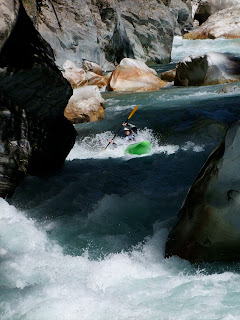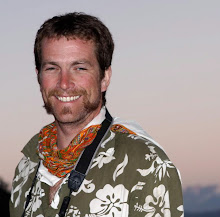

Our next river trip was the Alaknanda, on the way to the Pindar river. We did a short (17km) section that ends at a rapid named Hillary’s step, after Sir Ed’s last trip to the Himalaya, where he took a jet boat up the Alaknanda as far as this rapid.  The run was fantastic. Big and bouncy, fast class 4. We paddled 17km in about an hour and a half! The perfect break in the drive to the Pindar.
The run was fantastic. Big and bouncy, fast class 4. We paddled 17km in about an hour and a half! The perfect break in the drive to the Pindar.
 Shalab had given us a detailed description of the logistics and route for a 3 or 4 day trip on a river called the Pindar. It drains the Pindari Glacier and the valley is one of the last major drainages in Uttarachand to see roads and other modern infrastructure. Because of the lack of roads, it requires a 20km trek along the popular Pindari Glacier trekking route, from the road end at Lokharket, up and over the Dhakuri Kal Pass and down to the Pindar river. Shalab had described the route they had taken a few years ago, and suggested that we may be able to drive further than they had, but we quickly realised that we were in for a much longer walk!
Shalab had given us a detailed description of the logistics and route for a 3 or 4 day trip on a river called the Pindar. It drains the Pindari Glacier and the valley is one of the last major drainages in Uttarachand to see roads and other modern infrastructure. Because of the lack of roads, it requires a 20km trek along the popular Pindari Glacier trekking route, from the road end at Lokharket, up and over the Dhakuri Kal Pass and down to the Pindar river. Shalab had described the route they had taken a few years ago, and suggested that we may be able to drive further than they had, but we quickly realised that we were in for a much longer walk!
Predictably, the road was destroyed by landslides, even before we could get to Lokharket, so we loaded our boats with gear and food for 3 days, and began the long, steep climb up the old road to Sog, where we were told we could arrange porters. We arrived late in the afternoon, and seemingly, our state of exhaustion provoked the local porter hustler to up the prices by about 300%. Harry, the porter hustler, invited us to his “restaurant” for dahl and chapattis, and we could talk about the price more then. His “restaurant” was his house, and it measured about 3m by 3m. His wife was cooking over a wood fire in the middle of the room and the lack of a chimney created a completely unbearable atmosphere. We sat outside. The grand price of 1000 Rupees, plus food, was agreed upon for a porter to carry an empty kayak over the pass and down to the river. We would meet at Harry’s at 7:30 for breakfast and head off soon after, with the porters that he would find in the morning.
We woke in a stunning position, high on the ridge, with a group of Nepali porters, eagerly asking for work. They offered their services for 600 Rupees (NZ$17). We still dined at Harry’s restaurant, but ditched the porter hustler in favour of the Nepalis, who are famed for their legendary carrying skills and mountain fitness.
 We had climbed 500m the previous day, which left us a 1200m climb up to the Dhakuri Kal pass (2932m). The trail was a beautifully constructed pathway that had obviously been used for centuries. Our pace, with camping gear, kayaking gear and food, was about the same as our porters, and once we’d settled into the pace, the trek became less of a slog, and we began to thoroughly enjoyed the relaxed atmosphere and clean air of the mountains.
We had climbed 500m the previous day, which left us a 1200m climb up to the Dhakuri Kal pass (2932m). The trail was a beautifully constructed pathway that had obviously been used for centuries. Our pace, with camping gear, kayaking gear and food, was about the same as our porters, and once we’d settled into the pace, the trek became less of a slog, and we began to thoroughly enjoyed the relaxed atmosphere and clean air of the mountains. 
 The pass was a welcome sight, and once refreshed we headed down the steep slopes of the Pindar valley at double speed. Our porters still had to walk home!
The pass was a welcome sight, and once refreshed we headed down the steep slopes of the Pindar valley at double speed. Our porters still had to walk home!
We camped on a flat paddock next to the river, close to the village of Dhakuri, about 3km downstream of the confluence of the Sunderdhunga Gad and the Pindar river. The water was the clearest green we had seen in India, and the flow looked great.
We slept like babies and woke early, with the usual crowd of onlookers, who observed our every move, as we made breakfast and prepared to get on the water. JJ had done some Google Earth scouting, and clocked the gradient of this river section at about 30m/km for the first 20km or so. This type of scouting is notoriously inaccurate, but the whitewater was just what we had hoped for.  Beautifully formed rapids, with clean water and just the right gradient to allow boat scouting, yet still provide fun and interesting moves.
Beautifully formed rapids, with clean water and just the right gradient to allow boat scouting, yet still provide fun and interesting moves.

Great class 3+/4 read and run medium volume creeking with a few beefier class 4+ drops entertained us all day. 

 The valley is sparsely populated, with only a few footpaths and 3 or 4 foot-bridges, so we saw very few people, and the usual river bank decorations of litter and shredded clothes were not visible here.
The valley is sparsely populated, with only a few footpaths and 3 or 4 foot-bridges, so we saw very few people, and the usual river bank decorations of litter and shredded clothes were not visible here. 
 We found ourselves scouting a much steeper section, late in the afternoon, and tried estimating our travel distance. We decided we had most likely paddled about 20km, and since the next section was going to take some time we opted to set camp.
We found ourselves scouting a much steeper section, late in the afternoon, and tried estimating our travel distance. We decided we had most likely paddled about 20km, and since the next section was going to take some time we opted to set camp.
We found a perfect, small sandy beach, surrounded by huge boulders about 10m from the river, at the top of the steep section. After clearing the tiger/leopard risk by lighting some highly suspect firecrackers, we settled into one of the best camp spots of all time. 
In the morning, we scouted the next section and decided that the first waterfall (right next to camp) was the only one we could safely do, for the first few hundred meters.  The portaging was not challenging, so we found ourselves back on the water very quickly.
The portaging was not challenging, so we found ourselves back on the water very quickly.
 More high quality class 4 boat scouting and short mini gorges carried us quickly downstream. The gradient slackened off, but our pace remained fast, with swift class 3 wavetrains and no need to stop.
More high quality class 4 boat scouting and short mini gorges carried us quickly downstream. The gradient slackened off, but our pace remained fast, with swift class 3 wavetrains and no need to stop. The fun was endless, but we were all eagerly hoping to see our take-out (Laxman and the van), before dark. We had planned for 3 days, so our food supply was a little low and another night out would be a hungry one if we could not find a village where we could buy supplies. Fortunately we came across a small village where we bought eggs, rice and onions-perfect!
The fun was endless, but we were all eagerly hoping to see our take-out (Laxman and the van), before dark. We had planned for 3 days, so our food supply was a little low and another night out would be a hungry one if we could not find a village where we could buy supplies. Fortunately we came across a small village where we bought eggs, rice and onions-perfect!
Our camp was on the main path of the hay collectors, bringing straw and hay back from the meadows to the village. We were visited by a few friendly local kids and presumably gave the whole town much to talk about for a few days.
In the morning we drifted downstream, to find more stunningly beautiful whitewater. Not challenging, but enjoyable and moving quickly.
When we eventually saw the van parked next to the river at Pulwara, we were weary, but still enjoying the river. We had paddled about 45km of some of the best whitewater in Uttarakhand.
The Pindar is one of the classiest river trips I’ve ever done, and has to be one of the World’s best multi-day kayaking adventures. Unfortunately there is a road being build into the upper part of the valley, to allow the construction of a hydro-electric dam, so the river’s days are numbered. Next year it may be possible to drive to the put-in, but in 2 years, the Pindar River will be gone.
This is a sad realisation, but we all felt lucky to have had the chance to get on this classic river. It may have only had 2 kayak descents, but hopefully it will see a few more before it’s dammed.

No comments:
Post a Comment